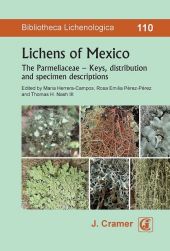 Neuerscheinungen 2016Stand: 2020-02-01 |
Schnellsuche
ISBN/Stichwort/Autor
|
Herderstraße 10
10625 Berlin
Tel.: 030 315 714 16
Fax 030 315 714 14
info@buchspektrum.de |

Maria Herrera-Campos, Thomas H. Nash, Rosa Emilia Pérez-Pérez
(Beteiligte)
Lichens of Mexico
The Parmeliaceae - Keys, distribution and specimen descriptions
Herausgegeben von Herrera-Campos, Maria; Pérez-Pérez, Rosa Emilia; Nash, Thomas H.
2016. VI, 723 S. 17 Abb. 220 mm
Verlag/Jahr: BORNTRAEGER 2016
ISBN: 3-443-58089-0 (3443580890)
Neue ISBN: 978-3-443-58089-6 (9783443580896)
Preis und Lieferzeit: Bitte klicken
With well over 2000 species the Parmeliaceae is the largest family of lichenized fungi. Mexico with its huge topographic relief and wide range of habitats is one of the major biodiversity hot spots in the world. Accordingly, it is not surprising that this volume documents over 20% of the world´s Parmeliaceae from this country. In fact a vast majority of the Parmeliaceae known from North America are covered in this volume. Descriptions (morphological and chemical), keys, distribution information and extensive specimen citations covering all states in Mexico are provided in the systematic treatments covering 450 species from Alectoria, Anzia, Bryoria, Bulbothrix, Canoparmelia, Cetraria, Cetrelia, Hypotrachyna, Flavoparmelia, Hypogymnia, Imshaugia, Kaernefelita, Letharia, Melanelixia, Melanohalea, Menegazzia, Montanelia, Myelochroa, Nodobryoria, Oropogon, Parmelia, Parmelina, Parmelinella, Parmeliopsis, Parmotrema, Parmotremopsis, Phacopsis, Protoparmelia, Pseudephebe, Pseudevernia, Pseudoparmelia, Punctelia, Relicina, Remototrachyna, Tuckermanella, Tuckermannopsis, Usnea, and Xanthoparmelia. Keys to genera are based on the most recent molecular data. All the species of Parmotrema known for North America are covered in the keys. The book begins with a review of the physiographic aspects and biodiversity of Mexico and proceeds to the first lichen community phylogenetic analysis for the major ecological communities in Mexico based on the Parmeliaceae. The book will be useful to anyone studying the lichens of Mexico as well as adjacent regions in Central America, the Caribbean, and the United States.


